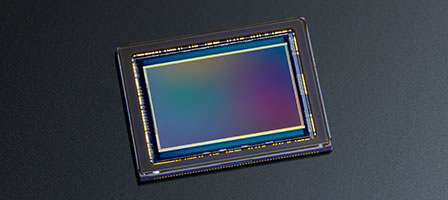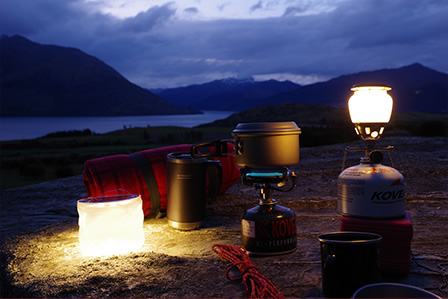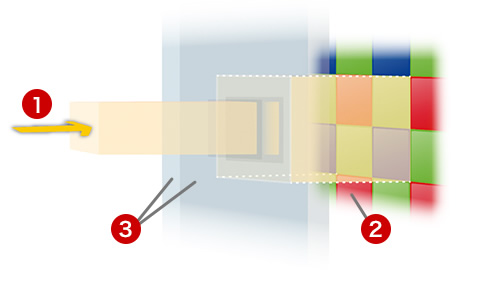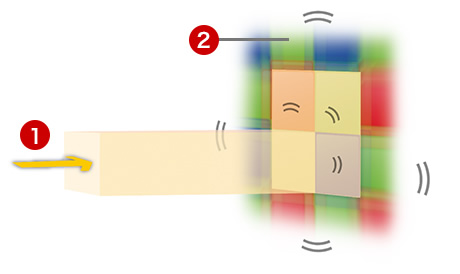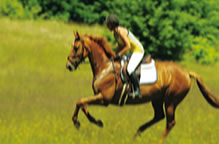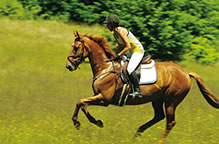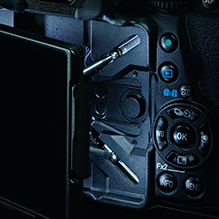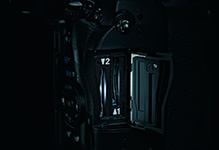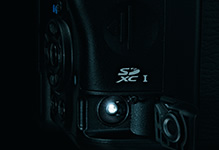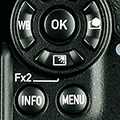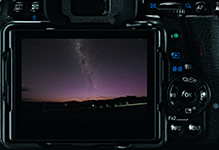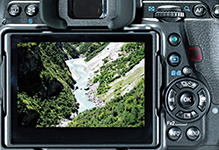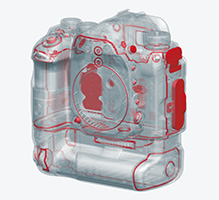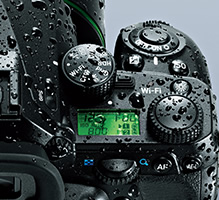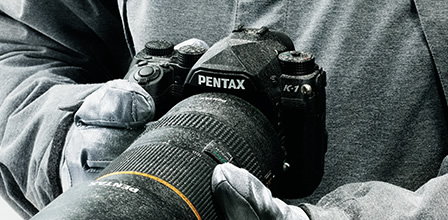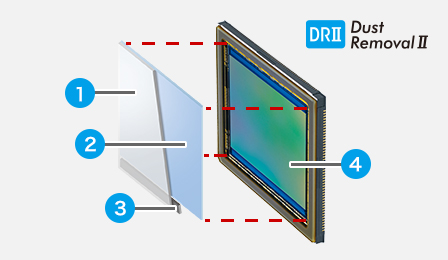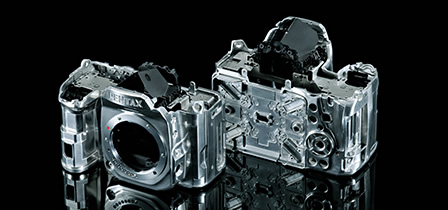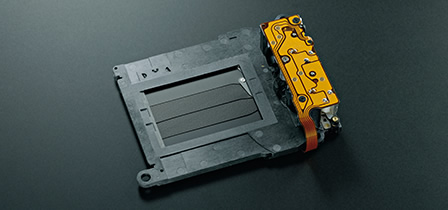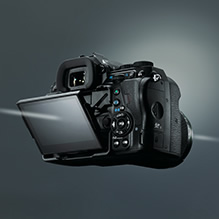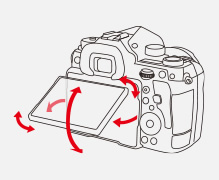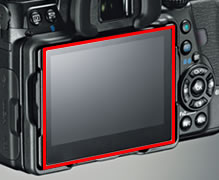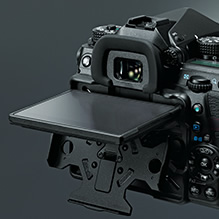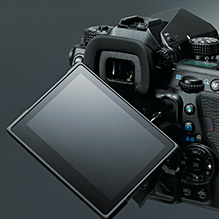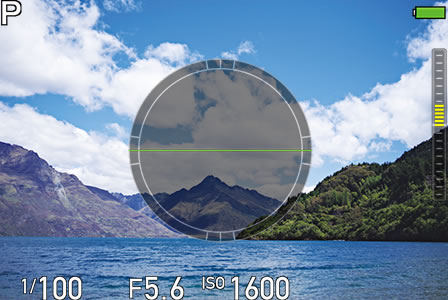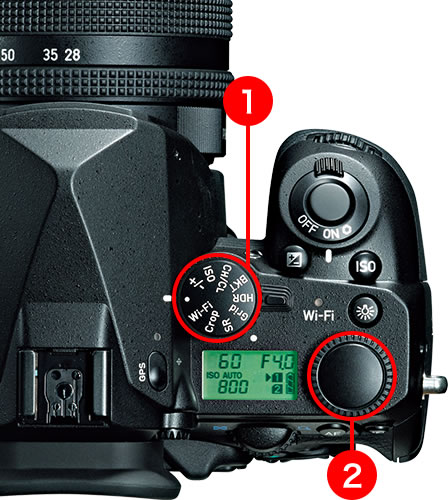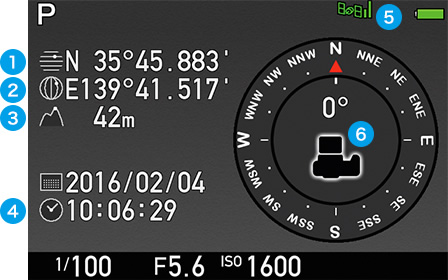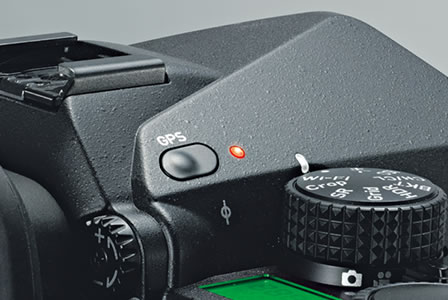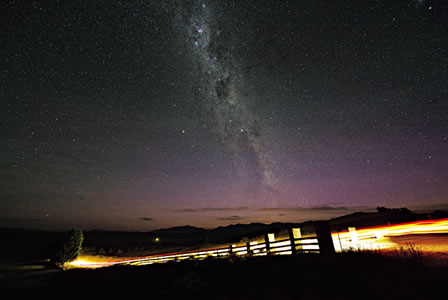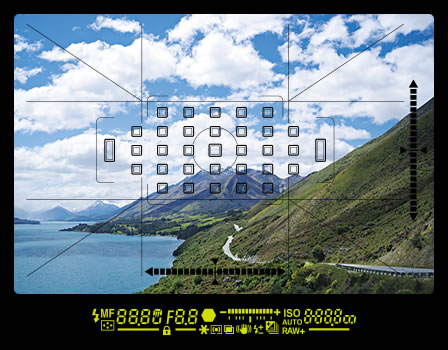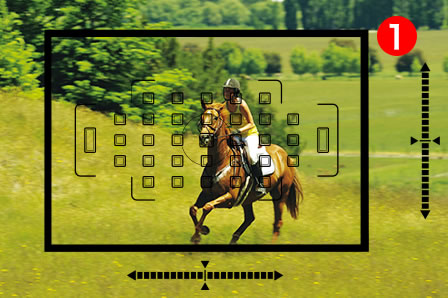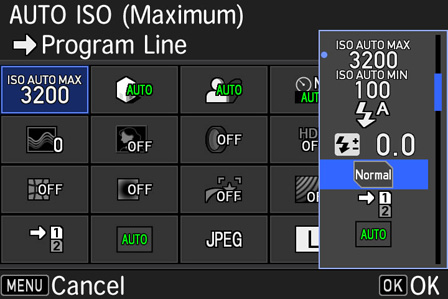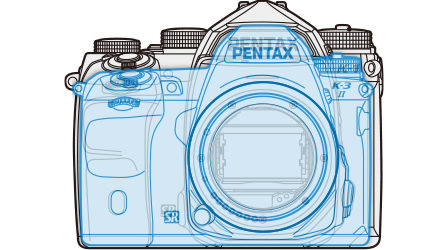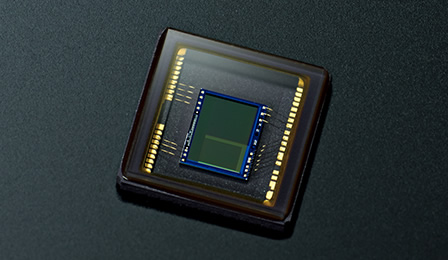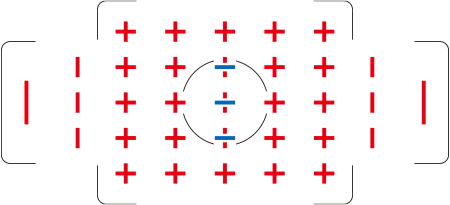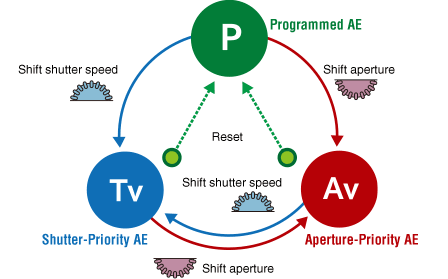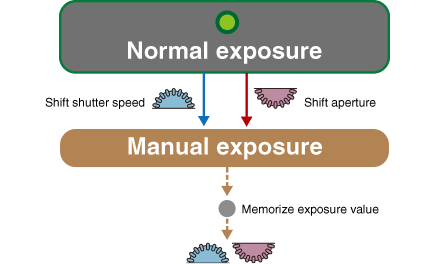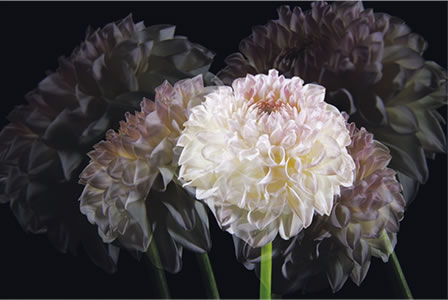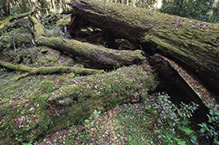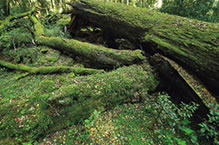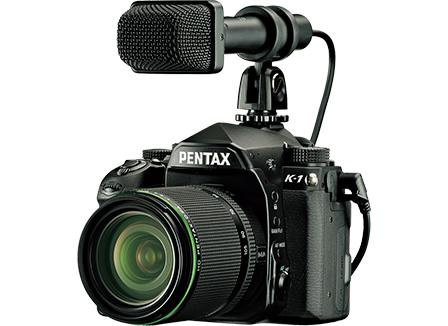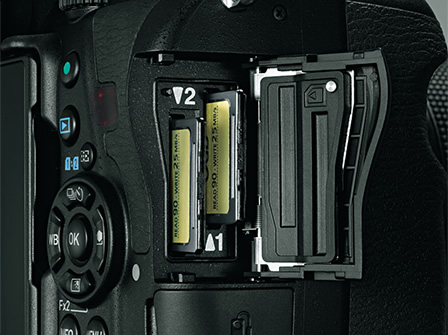PENTAX K-1 - Overview

Full Frame. Excellence Redefined.
- Approx. 36.4 megapixels, 35mm full-frame format CMOS sensor
- 5 axis, 5 shutter step built-in SR mechanism
- Pixels Shift Resolution, ISO 204800
- Newly developed image engine, PRIME IV
- Flexible Tilt Type LCD monitor
- AA Filter Simulator
- New AF system, SAFOX 12
- Built-in Wi-Fi, GPS, ASTROTRACER
- Dustproof, weather-resistant, -10℃ cold-resistant
Awardsread more
Links
Description
What’s the best camera for a photographer?
Throughout more than 50 years as a leading SLR camera manufacturer, PENTAX has always thought very seriously about this question, and developed the original technologies to provide good answers. It’s a history of never-ending innovation and evolution.
Based on its experiences and expertise accumulated over these years, PENTAX now has the final answer: a new 35mm full-frame digital SLR camera named PENTAX K-1. Proudly carrying the number “1” in its name, the K-1 reigns as the flagship of the acclaimed PENTAX K series.
While inheriting PENTAX’s traditional compact, durable body design, the K-1 adds essential values to the 35mm full-frame format, including state-of-the-art high-resolution technologies drawn from PENTAX’s development of medium-format models, an array of exclusive shooting features, and remarkable environmental adaptability in the field.
True to its number-1 naming, the PENTAX K-1 signifies the arrival of a new era in 35mm full-frame digital SLR cameras.
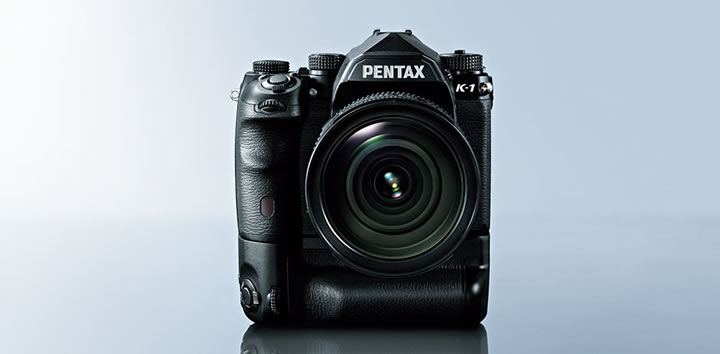
The K-1 assures the highest level of resolving power and sensitivity
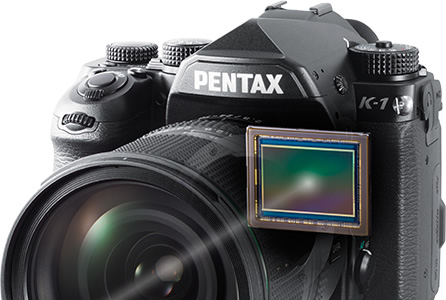
35mm full-frame CMOS image sensor
|
Approximately 36.4 effective megapixels |
|
Exceptional imaging power assured by a large-format sensor |
Exceptional resolving power supported by a high-resolution, AA-filter-free design |
|
The K-1 incorporates a newly developed 35mm full-frame CMOS image sensor, one that assures the highest image quality to be found in the K-mount SLR series. Thanks to its large imaging area and wide pixel pitch, this high-pixel sensor delivers lively, true-to-life images with rich gradation and minimal noise. Its shallow depth of field allows you to control the sense of depth and bokeh (defocused) effect at will.
|
Thanks to its approximately 36.4 effective megapixels, the K-1 delivers breathtaking, true-to-life images—the kind that will seize the viewer’s imagination. Its exceptional resolving power captures each leaf of a distant tree or every drop of a spray in the finest detail. Since it provides image data large enough to produce a brilliant A2-size print (at 300dpi), the photographer is assured of great flexibility in image composition, either by cropping the image during shooting, or trimming the captured image during processing. By processing large volumes of data with its 14-bit image-processing system, the K-1 delivers beautiful, rich-gradation images. AA-filter-free design, to optimize resolving powerAn optical AA (anti-aliasing) filter will affect the camera’s image resolving power, even though it will help reduce moiré and false color. The K-1 incorporates an AA-filter-free design to optimize the image resolving power of its high-pixel image sensor. |
PRIME IV
|
ISO 204800
|
|
A new imaging engine optimized for a 35mm full-frame image circle |
A combination of super-high sensitivity and exceptional image resolution |
|
The K-1 features a newly designed PRIME IV imaging engine. Compared with the previous PRIME III version, it is fine-tuned to process higher-resolution images, while boosting the operating frequency by nearly 50 percent. Its noise-processing algorithm has also been upgraded to capture beautiful, fine-gradation images at higher sensitivities. A combination of an advanced scene analysis system and new image-processing functions helps improve the accuracy and reliability of image reproduction. |
By taking full advantage of the image sensor excelled in noise-resistance performance and the PRIME IV imaging engine, the K-1 provides a top sensitivity of ISO 204800 (at standard output sensitivity). This not only delivers high-resolution images free of tone jumps and graininess at high-sensitivity settings, but also improves image quality in the low-sensitivity range. Since the K-1 allows you to raise the sensitivity level to capture images equal in image quality to those taken at lower sensitivities, it expands the boundaries of photographic expression. |
|
|
|
Pixel Shift Resolution System
Reproduction of true-to-life, super-high-resolution images beyond actual pixels
Reinforced with the SR (Shake Reduction) mechanism, the K-1’s Pixel Shift Resolution System* captures four images of the same scene by shifting the image sensor by a single pixel for each image, then synthesizes them into a single, super-high-resolution composite image. Compared to the conventional Bayer system, this innovative system obtains all RGB color data in each pixel to deliver beautiful images with far more truthful colors and much finer details, without any hint of false color. This system also reduces high-sensitivity noise to a minimum. The difference in image quality is evident at a glance, even without magnifying the captured image on a computer screen or producing a large-size print. Images captured by the Pixel Shift Resolution System can be saved as RAW-format files. You can developed these files within the camera body while adjusting various parameters or turning the Pixel Shift Resolution effect on and off to create a new image.
* When using this system, the user is advised to stabilize the camera firmly on a tripod during shooting by setting the drive mode to self-timer or remote control, or using the mirror lock-up function.
* When the subject is on the move or camera shake occurs, the desired effect may not be obtained.
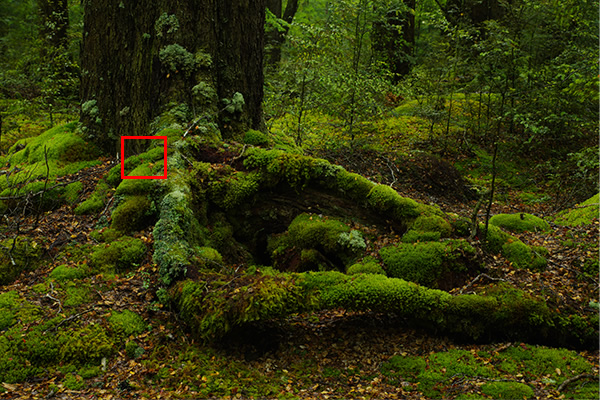
|
Pixel Shift Resolution |
Normal shot |
|
Color information obtained |
Color information obtained |
|
By taking four shots sequentially, each pixel obtains color and brightness information of every RGB. |
For each pixel, color and brightness information is obtained for one |
 |
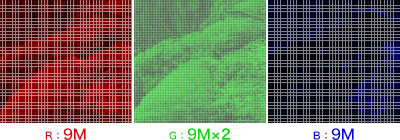 |
|
*High resolution and many gradations are achieved because the |
Due to color filter RGB proportions, the resolution for each color is |
|
Demosaic processing |
|
|
Estimate the deficient pixels by referring the neighbor pixel and outline information (pixel interpolation). |
|
 |
|
|
When there are instances where the estimated color and actual color |
|
| |
|
 |
 |
|
*Images are for representation purpose only. |
Motion Correction function 
When shooting an image with the Pixel Shift Resolution System, the K-1 provides a new Motion Correction function. When this function is activated, the camera automatically detects the amount of subject motion during continuous shooting and minimizes negative effects during the synthesizing process.*
* The movement may not be sufficiently corrected when the subject is moving in certain directions and/or patterns. This function does not guarantee that the movement will be properly corrected for all subjects.
AA filter simulator
State-of-the-art mechanism to optically minimize moiré and false color
By using the camera’s SR mechanism to apply microscopic vibrations to the image sensor, the PENTAX-original AA (anti-aliasing) filter simulator* effectively minimizes moiré and false color along the image’s edges, which are common problems when shooting subjects with minute patterns. The K-1 allows you to faithfully reproduce your creative intention on a captured image, either by simulating the AA-filter effect for well-balanced images or by opting for the AA-filter-free mode for greater resolving power.
*This function works most effectively with a shutter speed of 1/1000 second or slower.
*This function may not be combined with some shooting modes.
|
Principle of optical AA filter |
Principle of AA filter simulator |
|
|
|
![]() Light
Light ![]() Color filter
Color filter ![]() AA filter
AA filter
Lens Aberration Correction and Fringe Compensation* |
Fine Sharpness and Extra Sharpnes
|
|
High-quality image reproduction a the image field, with effective compensation of aberrations |
Sharpness-enhancing tools to greatly improve the image rendition of high-pixel photography |
|
The K-1 effectively compensates for the distortion, vignetting and chromatic aberration caused by specific lens properties, and captures high-quality images with edge-to-edge sharpness. It even compensates for the fringe effect during RAW-data development. *Available in combination with D FA-, DA-, DA L- and FA-series lenses. However, some of these lenses may not be compatible with these functions. |
No matter how many pixels and how much resolving power an image sensor may provide, the captured image can appear as a low-resolution image if the subject is outlined with thick lines. The K-1’s Fine Sharpness function outlines the subject with thinner, more natural lines than those created by normal processing to produce a high-quality, fine-detailed image. It allows you to create a fine piece of art, with a true-to-life description of the subject. The K-1 also provides an Extra Sharpness function, which emphasizes the subject’s outline more prominently with much finer lines, making it particularly useful for enhancing the outline of a low-contrast subject. |
The K-1 overcomes challenging field conditions, such as poor weather, darkness and freezing temperatures.
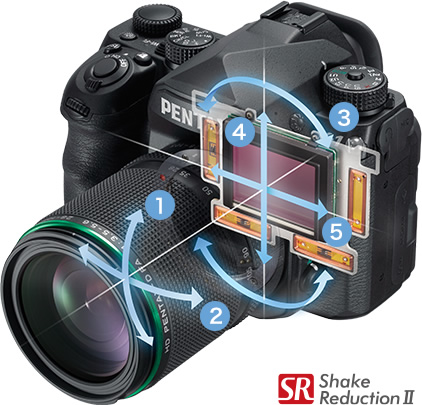
 Shake reduction along five axes
Shake reduction along five axes
![]() Pitch and yaw
Pitch and yaw ![]() Roll
Roll
![]() Horizontal and vertical shift
Horizontal and vertical shift
SR II in-body shake reduction mechanism 
The world’s first five-axis, five-shutter-step camera shake compensation*
|
The PENTAX-original sensor-shift-type shake reduction mechanism has been upgraded to provide optimum compensation for all lenses used in handheld shooting. The new-generation SR II (Shake Reduction II) features a five-axis mechanism to compensate for camera shake caused by horizontal and vertical shift** (often generated in macro photography) and camera shake caused by roll, which is difficult to handle by lens-installed shake reduction mechanisms, in addition to more common camera shake caused by pitch and yaw. The SR II unit is controlled with great precision as soon as the camera’s power is turned on, and provides a wide compensation range — as much as five shutter steps*** — to expand the limits of handheld shooting. *For a 35mm full-frame digital SLR camera, as of February 2016 (based on RICOH IMAGING research). |
|
|
|
|
|
Compatible with panning shots
When taking a panning shot, this mechanism efficiently controls the SR unit to detect only the direction of the camera’s movement, while compensating for all other affecting vectors. Because of this, the K-1 captures beautiful, high-resolution images both in normal shooting and panning photography, without requiring any switching operation.
Operation Assist Light
|
|
|
|
|
|
High-precision AE/AF operation at –3EV illumination |
Outdoor-oriented LCD monitor
|
|
|
Extra-accurate auto-exposure and autofocus control, even in the dark |
Single-action setting of LCD monitor’s brightness |
|
|
An illumination level of –3EV makes it difficult to see a subject with the naked eye, and almost impossible to make accurate focus with manual focusing. Even under such low-illumination conditions, the K-1 assures high-precision auto-exposure and autofocus operations.* Thanks to its upgraded algorithm, its autofocus response time for poorly illuminated subjects is greatly reduced. Coupled with its super-high-resolution imaging power, the K-1 delivers exceptional shooting performance in dark locations. |
With a single push of a button, the K-1’s new Outdoor View Setting mode displays five brightness settings on its LCD monitor, allowing you to easily and quickly set the desired brightness level for a given location — brightening the monitor under dazzling sunshine or darkening it under starlit skies. |
|
|
* Light metering measured at ISO 100 and with a 50mm F1.4 lens; focusing measured at ISO 100, at room temperature and with 25 middle sensors. |
|
|
Dependable dustproof, weather-resistant construction
|
A completely environment-resistant imaging system, with a weather-resistant lens A combination of the K-1’s 87 sealing parts with an AW- or WR-series lens is mounted,* the K-1 and its lens forms a remarkable digital imaging system totally resistant to demanding environmental factors.
|
|
|
–10°C cold-resistant construction |
DR II (Dust Removal II) mechanism |
|
Unmatched reliability proven under vigorous testing conditions |
Effective removal of foreign particles from the image sensor |
|
Anticipating use in cold locations, PENTAX has subjected the K-1 to exacting environmental tests at temperatures as low as –10°C, and gathered a vast array of data on operational precision, response and stability of mechanisms and circuits, as well as fluctuations in battery voltage.* As the result, the K-1 assures solid, trouble-free operation even at freezing temperatures. |
Using its piezoelectric element, this innovative mechanism applies ultrasonic vibrations to the optical glass panel placed in front of the image sensor. This effectively removes all dust particles clinging to the image sensor surface, and prevents annoying dust spots from appearing on a captured image. |
|
* Battery performance declines as the temperature goes down. When shooting in cold environments, the user is advised to carry spare batteries and keep them warm by storing them in an inside pocket.
|
|
![]() UV/IR-cut filter
UV/IR-cut filter ![]() Absorption-type IR-cut glass
Absorption-type IR-cut glass ![]() Piezoelectric element
Piezoelectric element ![]() CMOS image sensor
CMOS image sensor
High-rigidity, extra-durable body |
Extra-durable shutter unit
|
|
A shell structure shielding a metallic chassis with a magnesium alloy casing |
Withstanding 300,000 shutter releases for professional use |
|
The K-1’s exterior casing is made of highly rigid, lightweight magnesium alloy, which provides excellent shock-resistance and electromagnetic shielding performance. By coupling it with a high-rigidity metallic chassis housing the core components, the K-1 forms a compound structure to assure outstanding durability and exceptional reliability. |
After a series of exacting performance tests, the K-1’s shutter unit has proven its exceptional durability by withstanding a total of 300,000 shutter releases. It assures outstanding operational precision and exceptional durability required for exacting professional work. |
|
|
|
Innovative shooting-support features to capture eye-catching masterpieces
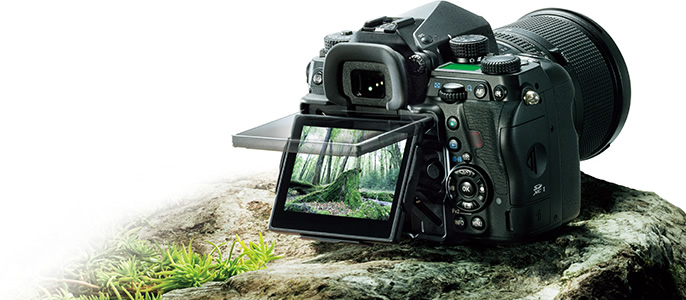
Flexible Tilt-Type LCD monitor 
Innovative mechanism to tilt the monitor to any desired angle along the optical axis
|
Aiming at aligning the photographer’s line of sight precisely with the camera’s optical axis while providing a flexible angle adjustment, PENTAX has designed an ideal LCD monitor for the K-1 by creating an innovative mechanism that supports the monitor with four stays. This monitor has reached two difficult goals that conventional monitors have failed to attain: no deviation from the optical axis; and unrestricted tilt in all directions, horizontally or vertically. You can even tilt it up to a nearly 90-degree angle for low-angle and waist-level photography. |
|
|
|
|
|
|
|
|
|
・Vertical tilt: approx. 44° |
Air Gapless LCD monitor |
||
Live View shooting |
Auto Horizon Correction and Composition Adjustment |
|
An array of creative tools to assist creative photography |
Convenient tools to compose well-balanced images |
|
In the Live View mode, the K-1 provides a wide range of picture-taking tools. Thanks to its Flexible Tilt-Type LCD monitor, you can clearly view the on-screen image from different angles to optimize shooting comfort. Main Live View shooting functions
|
By taking advantage of its SR mechanism, the K-1 helps you compose well-balanced, flawless * Maximum compensation angle: approx. ±2° (approx. ±1° with SR mechanism activated) ** Maximum compensation range: ±1.5mm (±1mm along the axis of rotation) or ±1° |
Digital levelAccurate detection of camera tilt without removing the eye from the subject The K-1’s Digital Level displays bar scales at the right side and bottom of the viewfinder to indicate the horizontal and vertical tilt of the camera, allowing you to confirm the horizontal and vertical alignment of the subject without taking the eye off the subject. You can also display the Digital Level on the LCD monitor during viewfinder shooting, Live View shooting and movie recording |
Sample of Digital Level display (during Live View shooting) |
|
|
Smart Function
|
|
|
Function Dial |
Setting Dial |
|
|
● |
Void |
|
|
+/- |
Exposure compensation value shift |
|
|
ISO |
ISO sensitivity shift |
|
|
CH/CL |
Switching between Continuous Shooting (with a choice of three drive modes) and Single Frame Shooting modes |
|
|
BKT |
Bracketing value shift in bracket shooting |
|
|
HDR |
Change of HDR shooting mode |
|
|
Grid |
Viewfinder shooting: ON/OFF Live View shooting: change of grid pattern |
|
|
SR |
Still-image shooting: ON/OFF of SR mechanism |
|
|
Crop |
Change of Crop setting |
|
|
Wi-Fi |
ON/OFF |
|
Built-in GPS module and Electronic Compass
Automatic recording of shooting position data
The K-1 features a built-in GPS module and Electronic Compass, which together display the camera's direction on the LCD monitor. These features allow you to attach Exif data to recorded images, including the location, direction and time of shooting (using Universal Time Coordinated). This comes in particularly handy in situations where you must make meticulous preparations in advance for the direction of shooting, such as the shooting of sunrise scenes and celestial bodies.
|
|
|
|
|
GPS Log to track the photographer’s movement The K-1’s GPS Log function automatically keeps track of the photographer's movement at fixed intervals. By loading a log file on your computer, you can trace the route you have traveled using a mapping application such as Google Earth™. |
ASTROTRACER 
|
Effortless tracking and photographing of celestial bodies without an equatorial telescope By making full use of its GPS module, Electronic Compass and SR mechanism, the K-1 simplifies the astronomical photography of celestial bodies, without the help for an equatorial telescope. Based on the latitude data obtained from GPS satellites and other affecting factors (the camera’s direction and horizontal/vertical tilt) obtained by its various sensors, the K-1 calculates the movement of celestial bodies, then synchronizes the movement of its image sensor with that of celestial bodies with great precision. Since it captures stars without a streaking effect even during extended exposures, you can record faint stars, which are difficult to detect with the naked eye, as point images. * The user is advised to use a tripod to stabilize the camera. * The user is advised to read the operating manual thoroughly before shooting. * ASTROTRACER cannot be used with some shooting modes, such as interval shooting and interval composite shooting. |
HD PENTAX-D FA 15-30mmF2.8ED SDM WR |
Optical viewfinder and customization
A well-defined view of the subject and intuitive operation to focus on the subject
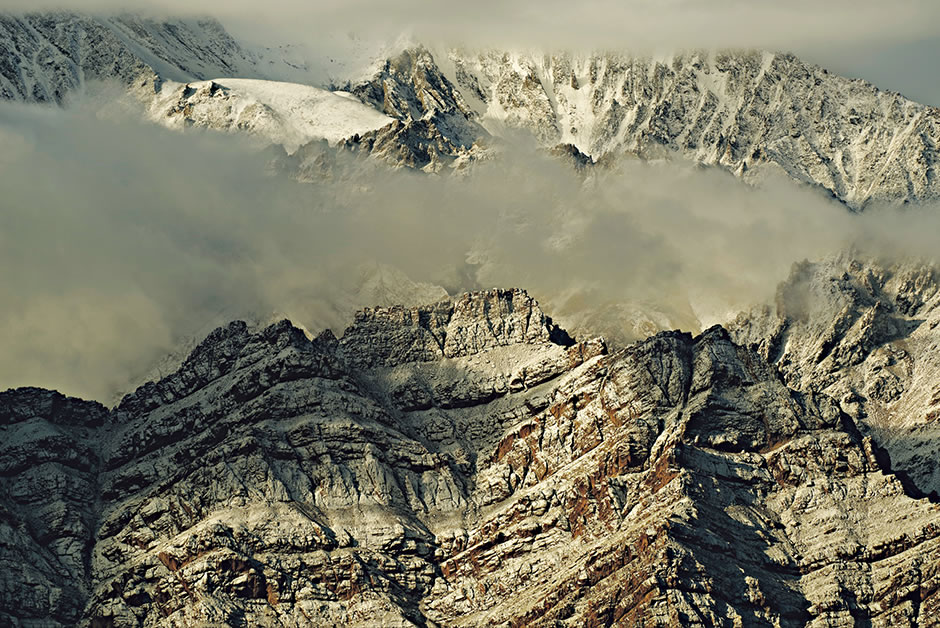
HD PENTAX-D FA 150-450mmF4.5-5.6ED DC AW
Aperture : F6.3 ; Shutter speed : 1/800 sec. ; Exposure compensation : 0.0EV ; Sensitivity : ISO 100 ; White balance : Color temperature assigned ; Custom image : Bright
Optical viewfinder with a nearly 100% field of viewAssuring a clear view of the field and ease of focus The K-1’s optical viewfinder provides a nearly 100-percent field of view and a 0.7-times magnification to deliver a sharp, crisp view of the subject and a large, well-defined image field, both of which are the benefits of the 35mm full-frame SLR camera. This viewfinder also provides a clear view of the image field free of aberrations, even at the edges. Its Natural-Bright-Matte III focusing screen* makes it easy to identify the in-focus point, even during manual-focus operation * The focusing screen is fixed on the camera body, and is not interchangeable. |
|
Transparent viewfinder display 
At-a-glance confirmation of the camera’s operational status
|
The K-1’s transparent LCD viewfinder display allows you to select desired data, such as a grid display, and monitor it in the viewfinder. It comes in handy when correcting the camera’s tilt using the digital level or rearranging the image composition using a grid pattern, without taking the eye off the subject. Digital Level The Digital Level displays the K-1’s horizontal and vertical tilt with two bar scales. Compared with the conventional type that utilizes an exposure bar scale, it not only makes it easier to identify the camera’s tilt, but also allows you to check the tilt and exposure status simultaneously. As the result, it greatly improves the camera’s operability during viewfinder shooting |
Selection of data on viewfinder display Transparent data to be displayed in the viewfinder (grid pattern, Digital Level, AF frame and spot-metering frame) can be turned on and off independently to accommodate varying shooting conditions and preferred shooting styles.
* All viewfinder display data, except the crop frame, is simulated to explain the function. |
All APS-C-format, K-mount interchangeable lenses are usable on the K-1
From ultra-wide angle to super telephoto, an entire selection of high-performance DA-series lenses can be used on the K-1 without any modification. They deliver exceptional image quality, despite their compact, lightweight design.
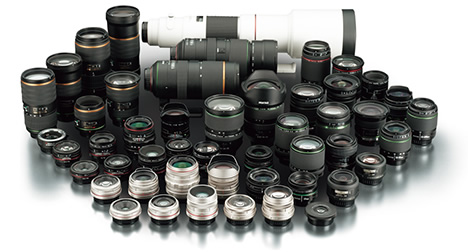
DA★ / DA Limited / DA Lenses
|
Fish-eye zoom |
smc PENTAX-DA FISH-EYE10-17mmF3.5-4.5ED[IF] |
|
Ultra-wide-angle |
smc PENTAX-DA 12-24mmF4ED AL[IF] |
|
Standard zoom |
smc PENTAX-DA★16-50mm F2.8ED AL[IF] SDMHD PENTAX-DA 16-85mmF3.5-5.6ED DC WRsmc PENTAX-DA 17-70mmF4AL[IF] SDMHD PENTAX-DA 18-50mmF4-5.6 DC WR REsmc PENTAX-DA 18-55mmF3.5-5.6AL WR HD PENTAX-DA 20-40mmF2.8-4ED Limited DC WR |
|
Telephoto zoom |
smc PENTAX-DA★50-135mmF2.8ED[IF] SDMsmc PENTAX-DA 50-200mmF4-5.6ED WRHD PENTAX-DA 55-300mmF4-5.8ED WRsmc PENTAX-DA★60-250mmF4ED[IF] SDM |
|
High-magnification zoom |
smc PENTAX-DA 18-135mmF3.5-5.6ED AL[IF] DC WRsmc PENTAX-DA 18-270mmF3.5-6.3ED SDM |
|
Ultra-wide-angle |
smc PENTAX-DA 14mmF2.8ED[IF]HD PENTAX-DA 15mmF4ED AL Limited |
|
Wide-angle |
HD PENTAX-DA 21mmF3.2AL Limited |
|
Standard |
smc PENTAX-DA 35mmF2.4AL |
|
Medium telephoto |
HD PENTAX-DA 40mmF2.8 Limitedsmc PENTAX-DA 40mmF2.8 XS |
|
Telephoto |
smc PENTAX-DA 50mmF1.8smc PENTAX-DA★55mmF1.4 SDMHD PENTAX-DA 70mmF2.4 Limitedsmc PENTAX-DA★200mmF2.8ED[IF] SDMsmc PENTAX-DA★300mmF4ED[IF] SDM |
|
Super-telephoto |
HD PENTAX-DA 560mmF5.6ED AW |
|
Standard/Macro |
HD PENTAX-DA 35mmF2.8 Macro Limited |
* The lens categories are classified in the Crop mode.
Crop mode
Automatic switching of an image area with attachment of a lens
|
When a DA★-, DA Limited- or DA-series lens is mounted on the K-1, its Crop mode automatically switches an image area to the APS-C size covering the middle section of the image field, while displaying the cropping frame in the viewfinder. It not only assures high-resolution images with approximately 15.36 effective megapixels, but also provides an efficient AF sensor coverage of the image area for more flexible image composition during autofocus operation. When you select the FF (Full Frame) setting of the Crop mode, you can even capture a 35mm full-frame image with a DA-series lens.* * With certain lenses and/or under certain photographic conditions, a captured image may suffer a drastic drop in brightness and/or resolution in the areas outside the APS-C image area. This setting does not provide compensation of various lens aberrations. |
Viewfinder display in the Crop mode (APS-C image area)
* This image displays all AF sensors for an explanatory purpose. |
Customization
Creating your personal K-1 by customizing camera operations to your preference
The K-1 provides a wide range of customization settings to optimize the ease and comfort of camera operations. These settings have been designed to expand the functions of the USER Mode and the Fx (function) buttons, improve accessibility to desired functions on the control panel, and prevent accidental operational errors.
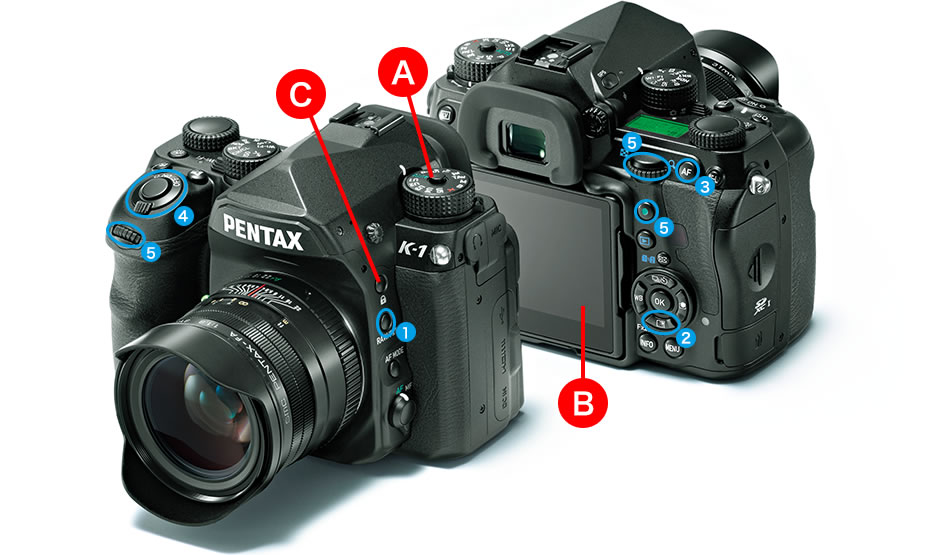
|
Five different combinations of the most frequently used functions can be assigned to this mode to handle specific subjects or creative intentions.
This panel displays a list of the functions and their status on the LCD panel, while allowing you to change the contents and/or order of listed functions to suit your shooting style.
|
Customization buttons
Custom Functions |
|
|
In order to prevent accidental setting changes, the K-1 provides a lock button to temporarily inactivate control buttons and dials. It offers you a choice of two lock functions: Type 1 to prevent unintended exposure setting changes; and Type 2 to prevent operational setting changes. |
|
|
|
Lockable buttons and dials: |
||
|
Type 1 Type 2 |
||
Compact, solid body
|
Remarkable maneuverability, despite the 35mm full-frame design The K-1 inherits PENTAX’s development concept of a compact body and ease of handling in the field. PENTAX has completely restructured the mechanical unit containing the shutter charge and mirror driving mechanisms, while repositioning the finder unit to keep the camera’s height to a minimum. PENTAX’s advanced high-density packaging technology has succeeded in creating a compact, maneuverable body for the new K-1. |
Front: PENTAX APS-C-size SLR camera |
|
Floating Mirror Structure In order to accommodate the 35mm full-frame image sensor and cover the light flux of the large viewfinder with a nearly 100-percent field of view, it was necessary to increase the size of the main mirror and mirror box. To minimize the size of the mirror box, PENTAX has developed a new mechanism that retracts the main mirror as it swings upwards.
|
Conceptual image of the Floating Mirror Structure |
Image shooting featuresA host of picture-taking functions to capture a decisive moment without failure HD PENTAX-D FA 24-70mmF2.8ED SDM WR |
 |
PENTAX Real-time Scene Analysis System
Optimizing the performance of AE and AF systems and the ease of image composition
|
Supported by the approximately 86,000-pixel RGB light-metering sensor and the new PRIME IV imaging engine, the PENTAX Real-time Scene Analysis System analyzes such factors as brightness distribution in the image field, the subject’s primary color and its motion with great accuracy and efficiency. In addition, by adopting a breakthrough artificial intelligence technology called deep learning to its image detection algorithm*, this system assesses each individual scene more accurately, while optimizing the accuracy and performance of the light-metering, exposure-control and autofocus systems, and selecting the most appropriate finishing touch for a given scene or composition. * This RICOH-original technology is available during viewfinder shooting when the exposure mode is set to Scene Analyze Auto and the Custom Image mode is set to Auto Select. |
 |
SAFOX 12 
Newly developed AF system, with an expanded AF detection area
The K-1’s AF frame has been widened to optimize the ease of image composition over a larger 35mm full-frame image field. Thanks to the development of a new SAFOX 12 AF sensor module, its autofocus area is approximately 40 percent wider than a conventional AF frame.* In order to contain a longer optical path required for the expanded AF area within a compact housing, the K-1 features an innovative, efficient optical design in which the incoming light is turned back within the AF module. Thanks to the optimization of the condenser lens, it also provides an increased number of AF sensor points (33 in total). This state-of-the-art AF module boosts both compact dimensions and exceptional image-forming performance.
|
SAFOX 12 AF module This new AF sensor module features two reflex mirrors. By reflecting the incoming light flux twice on these mirrors, it provides a longer optical path, while its overall size has been kept nearly identical to that of SAFOX 11
A light source sensor is positioned next to the pentaprism to optimize autofocusing accuracy by compensating for focusing errors caused by specific artificial light sources. |
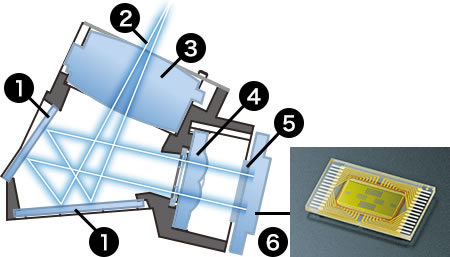 |
86,000-pixel RGB light-metering sensor
|
High-precision scene analysis based on the subject’s color, shape and motion |
|
33-point AF system with 25 cross-shaped sensors 
|
Assuring reliable, unfailing focus on the subject The K-1’s sophisticated 33-point AF system has a high-density distribution of AF sensors to effectively monitor crucial areas of the image field, while providing 25 cross-shaped sensors to assure extra-accurate focus on the subject. |
|
AF system with F2.8 luminance flux linear sensors
Three center sensors are designed to detect the luminance flux of an F2.8 lens for high-precision autofocusing. When using a very fast lens with a shallow depth of field, these sensors can greatly improve the focusing accuracy.
|
Zone Select |
Select-area expansion |
|
This mode lets you select a set of nine points forming a square, which can be shifted as desired by moving the center point. It detects a subject placed within this square, optimizes the focus, and tracks its movement — all automatically. |
This mode lets you select one of 33 AF points to focus on the subject, and makes the K-1 automatically track the subject and refocus on it with the help of the neighboring points, even when it moves away from the initial point. You can select the desired expansion area from nine, 25 or 33 points.* The number of AF points may decrease if the selected expansion area includes an area or areas outside the AF frame. |
 |
|
Auto tracking with PENTAX Real-time Scene Analysis System
Supported by the PENTAX Real-time Scene Analysis System, the K-1’s Auto Tracking function accurately detects the subject’s motion based on various factors including color, then keeps pinpoint focus on the subject throughout the imaging process by automatically shifting the in-focus point.
Scene Analyze AUTO 
Much-improved accuracy, through the adoption of artificial intelligence technology
|
Supported by the PENTAX Real-time Scene Analysis System, the K-1’s Scene Analyze AUTO mode automatically optimizes exposure settings, and selects the most appropriate finishing touch for your subject. When using the optical viewfinder, it is also assisted by an algorithm that adopts the deep learning artificial intelligence technology, and makes an extensive analysis of a given scene based on the enormous volume of data accumulated from previous scenes. |
|
Multi-mode AE system |
1/8000-second high-speed shutter |
|
A choice of distinctive auto-exposure modes |
Exceptional operational accuracy and remarkable durability |
|
In addition to the conventional Program (P), Aperture-Priority (A) and Shutter-Priority (Tv) modes, the K-1 also provides the PENTAX-original Sensitivity-Priority (Sv) and Shutter-speed/Aperture-Priority (TAv) modes, both of which assure proper exposure on the subject by factoring the ISO sensitivity more prominently into exposure-control operation. This multi-mode system assures more flexible control of exposure settings to express the subject’s motion or the depth of field. It also provides a wide exposure compensation range of ±5EV (in still-image shooting) to expand a range of exposure control. |
The K-1 features an electronically controlled, vertical-run shutter to optimize the performance of the 35mm full-frame image sensor. With a top speed of 1/8000 second, it allows you to open up the aperture, even in bright locations, and take full advantage of the bokeh (defocus) effect created by the large image sensor. It also provides a flash synchronization speed of 1/200 second. Symbolizing the K-1’s field camera concept, this unit is designed to be compact and lightweight, with a well-balanced combination of high-precision operation and outstanding durability. |
High-speed drive mode
|
Large image recording capacity in continuous shooting |
|
Flawless continuous shooting at approximately 4.4 images per second |
A maximum of 100 images captured at a high-quality 36-megapixel level |
|
The K-1 provides high-speed continuous shooting at a top speed of approximately 4.4 images per second (at CH setting). You can also switch instantly to an optional speed setting of three images per second (CM) or 0.7 images per second (CL) using the main menu or Smart Function. In the APS-C Crop mode, the drive speed can be boosted to as high as approximately 6.5 images per second to assure quick response to fast-moving subjects. |
Thanks to its large-capacity buffer memory, the K-1 lets you record a large number of images during continuous shooting: approximately 70 JPEG images (or approximately 17 RAW images) at CH setting; approximately 100 JPEG images (or approximately 20 RAW images) at CM setting, or approximately 100 JPEG images (or approximately 100 RAW images) at CL setting.* * These figures are an approximate number of images recordable in the 35mm full-frame format, in the JPEG L-size Best format, and at ISO 100 |
Hyper Program and Hyper Manual
Flexible control of the depth of field and the subject’s motion
In the Program (P) mode, the K-1 features the PENTAX-developed Hyper Program mode, which allows you to set a desired shutter or aperture speed using the front and rear e-dials, while retaining a proper exposure level. This eliminates the need for turning the model dial when switching to the Tv or Av mode.
![]() Front e-dial
Front e-dial ![]() Rear e-dial
Rear e-dial ![]() Green button
Green button ![]() AE-L button
AE-L button
|
Conceptual diagram of Hyper Program mode |
Conceptual diagram of Hyper Manual mode |
|
|
The combination of aperture and shutter speed can be changed without affecting the memorized exposure value. |
|
In the Hyper Manual (M) mode, one push of the green button instantly sets the same aperture and shutter-speed settings as those of the P mode for proper exposure. Then, you can adjust the exposure to a desired level using the front and rear e-dials. With the AE-lock function, you can even shift aperture and/or shutter-speed settings while retaining the initial exposure level. |
When you set the Smart Function to the ISO mode, you can enjoy more flexible control of the three primary exposure parameters — aperture, shutter speed and ISO sensitivity — in both the P and M modes, using a combination of the front and rear e-dials and the setting dial. |
Image composition and shooting functions
For freedom of creativity and boundless inspiration

HD PENTAX-D FA 24-70mmF2.8ED SDM WR
Aperture : F8.0 ; Shutter speed : 1/500 sec. ; Exposure compensation : -0.3EV ; Sensitivity : ISO 100 ; White balance : AWB ; Custom image : Landscape
Custom Image
Effortless expression of the ideal tone and shade for each subject
|
The K-1’s Custom Image function allows you to apply the preferred finishing touch to your image, based on your subject or creative intentions. With the addition of Auto Select, in which the camera automatically detects the type of scene or subject and selects the best finishing touch for you, and Flat, which produces a base image most tolerant to retouching, the K-1 now provides a total of 13 Custom Image modes.* Each mode provides minute adjustment of parameters such as saturation, shade, key, contrast and sharpness.** * The Custom Image mode is fixed to Auto Select when the camera’s exposure mode is set to AUTO. ** Adjustable parameters may vary depending on the selected Custom Image mode. |
Flat |
|
A selection of Custom Image modes
|
Bright |
Clarity control and Skin Tone correction* 
Compensation of the subject’s texture, while retaining the image’s overall sharpness
|
The Clarity control function is an image-processing technology * Both of these functions are technologies developed by RICOH Co., Ltd. ** The Skin Tone correction function can be activated only when the Face |
Clarity Control: -4 Clarity Control: -0 Clarity Control: +4
Skin Tone correction: OFF Skin Tone correction: ON |
HDR Faithful reproduction of highlights and shadows
|
Multiple exposure Three ways to synthesize highly creative images
accumulation |
Digital filters For creating a dramatized work of art with special visual effects |
CTEFor expressing the colors of the mind, rather than truthful color reproduction |
|
AWB CTE |
Movie recording |
4K-compatible Interval Movie shooting |
|
Full HD movies with a beautiful bokeh effect |
Documenting a constantly changing subject in high resolution |
|
The K-1 records lively, true-to-life movies. Thanks to a shallow depth of field provided |
The K-1’s Interval Movie mode allows you to record still images of a slowly changing subject at a fixed interval, and link them into a single movie file. You can play back the 4K-resolution (3840 x 2160 pixels) movie file,* as if fast-forwarding the time on the screen. The K-1 also provides the Star Stream function, which lets you draw the magical traces of stars in a movie. |
|
|
* When playing back the movie file on a device other than the K-1, the user is advised to use a PC operating environment supporting 4K-resolution movie playback. |
Wi-Fi compatibility Remote control of the camera using a smartphone |
IMAGE Transmitter 2 compatibility
|
In-body RAW data developmentApplication of the desired finishing touch without a computer The K-1 provides in-body development of RAW-format files, with the developed files saved as separate JPEG or TIFF files. This offers greater flexibility in finishing a captured image more faithfully to your creative intention, without the help of a PC. Thanks to a wide range of adjustable parameters, you can add a desired finishing touch to your image regardless of a location, until you are truly satisfied with the result. The K-1 also features a newly designed user interface for more effortless, more flexible parameter control. |
Dual card slotLarge-volume image data filing on two SD memory cards The K-1’s card slot accepts two SD memory cards, with a choice of three data |
|
|
Digital Camera Utility 5
Exclusive software for high-quality finish and browsing
Supported by the acclaimed SILKYPIX® image development engine, this software allows you to browse through captured images and develop them into RAW-format files on a computer. It is compatible with the K-1’s new features, including the Flat mode of the Custom Image function and the Motion Correction function of the Pixel Shift Resolution System.

.jpg)



